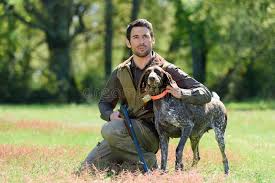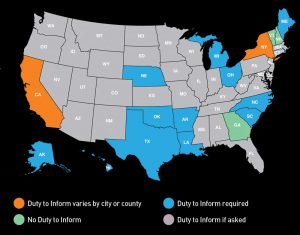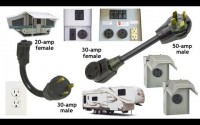Firearms Compliance Advice for RVers
Firearms Compliance for RVers

Man and gundog
Practical (not legal) advice on taking a trip with guns
Firearms compliance. To some people, traveling with firearms is just as regular as taking a trip with pets. Many motorhome owners take pleasure in the sporting elements of firearms and therefore want to travel with their competitors or searching firearms. Others wish to have a personal defense weapon while on the road to feel safe from either animal or criminal attacks. We don’t wish to be political and we want to make it clear that we are not using legal recommendations. This since we are not legal representatives. Also, our descriptions of guns laws are not claimed to be legal analyses or restatements of the law.
Despite the fact that we are not legal representatives, we will assist you choose the very best way to take a trip with firearms in your motorhome, need to you pick to do so. Due to the complexity of this subject we will not be able to inform you precisely how or where you can travel in your motorhome, or with which weapons you can take with you. It’s just not that easy, however we will point you toward some reputable sources that will assist you along the way. For this short article we are only focusing on travel in the USA. If you intend on hunting in Canada or driving to Alaska and going through Canada, this presents additional challenges that are outside the scope of this article. Mexico is yet another made complex topic we will not be covering.
Transferring or Concealed Carry?
If you decide to bring a weapon (which indicates anything other than keeping it in a locked case), an entire new set of laws enter into play with terms such as concealed carry versus open bring ending up being extremely important. It’s a virtual mine field of laws and it varies enormously from one state to another, and even within a state. Prior to you choose to carry a weapon, open or concealed, make certain you know the laws and, if needed, acquire a concealed carry authorization. In some states, open bring is legal and no permit is required; other states are not so friendly when it comes to carrying a weapon of any type. Following the laws to the letter will avoid felony charges.
The first difference is the distinction in taking a trip with a firearm, which is transferring, versus traveling with a hidden bring weapon on or off your body in a way that is easily available and/or packed. These are very different ways of carrying guns including numerous types of weapons and, obviously, the laws covering carrying versus hidden bring are likewise extremely different. Generally if someone is bring or concealing a weapon it is (however is not constantly) a handgun. A handgun, however, can be transported in a way that is ruled out hidden bring if you follow the ideal rules.
Motorhome Search Status
Although it is commonly thought that a motorhome is an extension of the “home” (and exempt from police searches without a warrant), when those motorhomes are on the road being used for transport they are dealt with precisely like an automobile or truck. When a vehicle or motorhome is on the road it is only subject to “possible cause” as the legal requirement for browsing.
The most safe bet when taking a trip with firearms (long weapons or pistols) is to call the state police, or the attorney general of the United States for the state( s) you are taking a trip through and ensure you totally comprehend the laws as they refer to your particular circumstance (concealed carry or otherwise) and type of weapon, magazines and ammunition. A lot of states have sites with this info as well.
<iframe width=”560″ height=”315″ src=”https://www.youtube.com/embed/dMJ4WxHIlT4″ frameborder=”0″ allow=”accelerometer; autoplay; encrypted-media; gyroscope; picture-in-picture” allowfullscreen></iframe>
Another excellent resource is www.concealedcarry.com, where you will find an interactive map that offers a great deal of information about the laws in all states. They also use a complimentary app called “Concealed Carry Gun Tools” to help navigate the maze of legally carrying a hidden weapon as you take a trip in the USA on a state-by-state basis.
Who is Eligible?
We are covering the topic of transporting lawfully owned guns, which suggests you need to be permitted to own a gun first. Federal law requires that an individual must be 18 years of ages to acquire a “long weapon” or long weapon ammunition, and 21 years of age in order to purchase a pistol or handgun ammo. Some states require owners to be 21 years old to purchase, own and possess long weapons, so even the legal age is a subject of difference among the numerous states. There are a number of other circumstances that avoid weapon and ammo ownership: a felony conviction, illegal alien status, an unethical discharge from the military, a person being mentally defective or who has actually been committed to a mental institution, and a specific founded guilty of a domestic violence offense.
Obviously, chauffeurs need to always follow all traffic laws whenever they are on the road. When you are carrying a weapon, one method of preventing a potential prolonged delay, (discussing why you have a weapon to an officer) is to drive in the best way possible while following all traffic laws. Speeding, distracted driving or road rage events have no place on the road at any time, so prevent anything that might trigger you to be in a position of needing to discuss why you are lawfully carrying or transporting a weapon.
The Right to Bear (and Transport) Arms
Complying with the FOPA is difficult in a motorhome due to the fact that the whole motorhome is accessible to its residents. Separate, locked cases need to be kept out of easy reach, and the key( s) must be put in a location that is not easily retrieved by the driver or passengers.
The first and most common law that is frequently mentioned relating to the transport of firearms is the 1986 Firearm Owners Protection Act (FOPA). Section 18 of this act is known as the safe passage act. In summary, what the FOPA offers is the capability for certain individuals (legal owners) to transport guns from one state where they are allowed to possess that weapon, to another state in which they can legally have it.
Unloaded and secured
To lawfully carry a firearm in compliance with the FOPA, it must be unloaded and secured in a case, and not easily available to the occupants. The ammunition also requires to be locked in a separate case and not quickly available. Considering that the entire “home” of the motorhome is open to the residents, this is harder than in cars and trucks, where operators can lock the items in the trunk, making them inaccessible. The term “unloaded” is also based on analysis, but the typical reasoning is that the magazine(s), and the weapon (including the chamber or cylinder) need to be empty. Unloaded might also imply no crammed speed loaders, moon clips, magazines, and so on.

A US map showing the various duty to notify laws
Some states have specific laws in place needing you to inform an officer if you have actually a hidden bring authorization and/or gun. Pay special attention to states in which you will be traveling, and describe www.concealedcarry.com for updated info.
Regional Laws
Transferring your weapon through some states gets difficult if you are passing through areas with stringent gun, ammunition and/or magazine capacity laws. Such as New York, Massachusetts, California, Maryland, New Jersey and Washington D.C., especially as it refers to handguns. Many analyses of FOPA state that a journey through these states requires to be undisturbed, indicating you can’t stay over night while in ownership of the firearm. That means no overnight outdoor camping or hotel stays in these states where possession of the weapon can be an issue. It would also be a fantastic concept to keep a copy of the FOPA laws in the locked case with your guns simply in case the officer is not familiar with them.
State laws can still have implications as well, so this is why it’s important to understand the law in every state you plan to travel. If you have any other documents that supports your legal carry, such as a hidden bring permit, make certain you always have those files with you, plus your state laws and/or the state you are traveling to and their laws relating to weapons. Paperwork of this type might not always help, but it does reveal the officer that you are trying to follow the law and could help you in some circumstances.
High-capacity magazines
High-capacity magazines present another obstacle if you are passing through particular cities or states that have rigid laws. It’s important to be familiar with those laws and ensure you comply. A pistol with a 15-round magazine (or specific kinds of ammo) that is legal in one state may not be in another. If you are a firearms competitor, some areas even have laws that relate to you and there are additional requirements– such as a defined window of time before and after the occasion, and requirements that you have the ability to record this occasion– as it connects to your journey.
Firearms Competitions
Throughout the U.S. there are numerous kinds of firearms competitors and events, just as there are with other sports such as golf, softball, soccer, and so on. Competitors include Trap, Skeet, Precision Rifle Series (PRS), IDPA, F-Class, FTR, Smallbore, Silhouette, 3-Gun, Benchrest, Western, Muzzle packing and a lot more. The National Rifle Association (NRA), which is only one organization that performs shooting occasions, sanctions more than 11,000 competitions and crowns 50 nationwide champs every year. According to the NRA, there are more than 300 colleges/universities that offer shooting programs for trainees.
Shooting sports might not be as popular as football or basketball, but they prevail. Naturally, the Olympic games include shooting events in both the summer season and winter events, and it is estimated that there are more than 390 million guns in the U.S. With numbers like these, it’s obvious why the topic of traveling lawfully with a firearm is an important one. Lots of shooting varieties even have RV parking on-site, which makes it a best combination to take a trip to these competitors in a motorhome.
Permits
When taking a trip with specialized weapons such as a competitors rifle, there may be extra limitations associated with transport, depending on the state and city. Since this rifle has a threaded muzzle gadget and it has high-capacity magazines, it could be bothersome in some locations although it is a small-caliber semi-automatic rifle, which is considered legal by many states.
Depending upon the state that provides your concealed carry authorization, it offers you particular rights of reciprocity in other states. Ensure you have a look at the interactive map previously pointed out so you can understand where you can and can’t bring a weapon. As an example, Maryland (as well as California, Illinois and a number of others) doesn’t acknowledge any other state’s bring licenses. Maryland is one of the states that concerns on a “might” basis and “might” issue homeowners a carry permit if they have a “excellent and substantial reason.”
Merely having a carry permit does not offer you the legal right to bring that weapon everywhere within that state. For example, lots of state or national parks have specific limitations, such as weapons being prohibited inside particular structures. Or even in car parks, so those laws have to be followed. It is your responsibility to understand these laws and follow them on a state-by-state and city-by-city basis. Usually, areas or structures that have special restrictions are published with signs. Note the lack of an indication forbiding a firearm is not constantly permission to have one there.
Stay Current
Another thing that makes carrying a weapon or transferring another challenging is that laws and reciprocity contracts are constantly changing; therefore, it is vital to check for these updates before taking a trip. Another important law to comprehend is when you are needed to notify police that you are carrying a weapon. These laws are frequently referred to as “Duty to Inform Laws.”
There are presently 13 states that need that you alert law enforcement (throughout any encounter, such as a moving-violation stop) that you have a weapon, even if they do not ask. Most of states need that you alert law enforcement only if asked. Meanwhile 3 states don’t need you to inform an officer. Please understand that California and New York have many variations of the notice laws which vary by city and county. This map can be viewed above, and at www.concealedcarry.com.
Do the Research
While all of us desire there was a simple answer to legally carrying or transporting a gun, this is a topic that is not simple at all. Use the resources discussed formerly to totally investigate the laws in the states you are traveling through to prevent any prospective issue. After getting in touch with the state police and/or the attorney general of the United States’s office/webpages, if you are still not comfortable, get the viewpoint of a firearms lawyer.
Keep in mind, we are not lawyers. Thus the suggestions we have offered must not be thought about as legal suggestions or interpretations of the law. You may believe that hiring an attorney is pricey or overboard. But if you make a mistake and are charged with a felony, a small consultation cost in advance with a great lawyer will be a small rate to pay.
“To lawfully carry a firearm in compliance with the Firearms owners security act, it must be unloaded and locked in a case, and not easily accessible to the occupants. The ammunition also needs to be locked in a separate case and not quickly accessible.”
Advertisement




Awesome post! Keep up the great work! 🙂
Great content! Super high-quality! Keep it up! 🙂